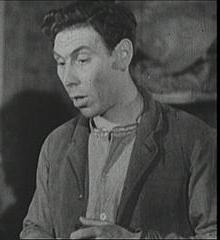The Harvest Shall Come facts for kids
Quick facts for kids The Harvest Shall Come |
|
|---|---|

John Slater as the farm laborer Tom Grimwood in The Harvest Shall Come
|
|
| Directed by | Max Anderson |
| Produced by | Basil Wright |
| Music by | William Alwyn |
| Cinematography | A.E. Jeakins |
| Studio | Realist Films |
| Release date(s) | 1942 |
| Running time | 33 minutes |
| Country | United Kingdom |
| Language | English |
The Harvest Shall Come is a British documentary film from 1942. It tells the story of farm workers and how important farming is, especially between 1900 and World War II. The movie focuses on the life of a farm laborer to show why these workers needed support. Basil Wright produced the film, and Max Anderson directed it. People really liked the film when it came out.
Contents
Making the Movie
This section explains how The Harvest Shall Come was made.
Filming Locations
The movie was filmed in real places, not in a studio. Even the indoor scenes were shot inside actual buildings. Most of the filming happened at Hill House Farm in Needham Market, Suffolk. Other parts were filmed in nearby Badley Hall and Willisham. Many people from the local area acted in the film as extras.
Behind the Scenes
This 33-minute documentary had music created by William Alwyn. The film was supported by the Ministry of Information, which was a government department during the war. It was also made for Imperial Chemical Industries (ICI), a big company. The movie aimed to show how using fertilizers could help farms grow more food.
Story of the Film
The film tells the story of a farm worker named Tom Grimwood and his life.
Tom's Early Life
The movie begins in 1900. Young Tom Grimwood leaves his family home with his small suitcase. He starts a job on a farm, earning a very small wage plus food and a place to live. The film explains that farm workers often had the lowest pay and the worst homes compared to other jobs. However, things had gotten a little better since 1870.
Tom learns many farming skills. He learns how to use a plough and a harrow, which were tools pulled by horses. He also learns how to milk cows and cut grass with a scythe.
Marriage and Hardship
When Tom turns 21, he gets a new job. This job pays a bit more, and it comes with a small, old cottage. This means he can now afford to marry his girlfriend.
Later in the film, Tom and his wife have three young children. Their cottage still doesn't even have a sink.
Wars and Wages
During World War I (1914–1918), farm workers finally started getting better wages. But after the war, even though politicians had made promises, wages dropped again. Tom wanted to find a better job, but he couldn't afford to leave his cottage.
Between the two World Wars, life in the countryside generally improved for many. But farm wages actually went down. This happened because cheap corn was being imported from other countries, which made prices for local crops fall. Tom even lost his job for a while and had to dig ditches for "relief" money. His son decided to move to the city, hoping for better chances there.
World War II and Hope
When World War II started in 1939, it became harder to import food. This meant that as much land as possible in Britain had to be used for farming. Because of this, conditions for farm workers improved again. Their wages went up, though prices for goods also increased.
A radio announcer in the film says that the government will take care of farm workers. But Tom's wife is doubtful. She says, "They said all that in the last war," remembering the broken promises from before. The film ends by showing how important farming is all over the world.
Main Actors
- John Slater: Tom Grimwood
- Eileen Beldon: Lil
- Victor Woolf: Bill
- Ernest Borrow: Squire
- Richard George: Farmer
- Edmund Willard: Commentator
- Bruce Belfrage: Commentator
More Films to See
- The Battle of the Harvests, a Canadian documentary from 1942.

